Classic Track & Road-Track Frames (pre-1970)
All our categories can be found in the sub-menu below – clicking on the category you want look at will get you directly to that page.
PLEASE NOTE: I measure all British, American and Japanese frames in inches ctt (centre to top) and convert to the nearest cm, conversely I measure all European and Italian frames in centimetres ctc (centre to centre) and convert to the nearest 0.25in.
A problem with all frames measured ctt is that the top measuring point varies from maker to maker and I try and second guess where the maker intended his measurement to be to – some mean top of top top tube, others the very top of the seat lug, and others to the seat lug top line…
FRAME SIZING
Do not assume that you will need a frame sized the same as your modern one – either seat tube or top tube. Fashion plays a great part in frame design and sizing. In the early years of the 20th century frames were sized as large as possible with virtually no seatpost showing … by contrast riders were advised in the 1920s to have as small a frame as possible.
Race/road frames from the 1920s/early 1930s will generally be sized about 3–5cm smaller than a modern frame but with a much longer top tube and shorter stems. Towards the end of the 1930s larger frame sizes became fashionable – up to 2cm larger than a modern frame. Top tube lengths were still longer used with shorter stems. In the 1940s and 50s frames were sized a bit larger still – 3–4cm more than a modern frame still with longer top tubes and shorter stems. In the 1960s and 1970s frames gradually reduced in size until the late 1980s. At the same time top tubes began to get shorter and stems longer.
Standover height is NOT a useful method of frame sizing either with modern or old frames. Short legged riders will rarely have much or any clearance between the top tube and their crotch unless the frame has a sloping top tube design. Taller riders also face other problems. A complete guide to frame sizing for frames of different periods is impossible to detail here. For frames from the 1980s onwards I suggest buyers look at Dave Moulton’s contributions on frame sizing. Possibly start off with http://davesbikeblog.squarespace.com/blog/2006/2/27/a-different-thought-on-frame-sizing.html
and then look at: http://www.davemoultonregistry.com/MoultonFrameSizeChart
I am willing to advise any customer on frame sizing with older frames.
Featured Frames
British and American road frames smaller than 21.5in
British and American road frames 21.5in–22.5in
British and American road frames larger than 22.5in
Bargain Basement
Classic Road frames pre-1970 smaller than 21.5in
Classic Road frames pre-1970 21.5in–22.5in
Classic Road frames pre-1970 larger than 22.5in
Classic Track & Road-Track frames pre-1970 (look below)
European frames 56cm or smaller
European frames larger than 56cm
Italian frames 56cm or smaller
Italian frames larger than 56cm
Lo-Pro & Retro Time Trial frames
Touring frames
Track frames

Please contact me at: hilarystone@hilarystone.com to check on availability and confirm shipping cost.

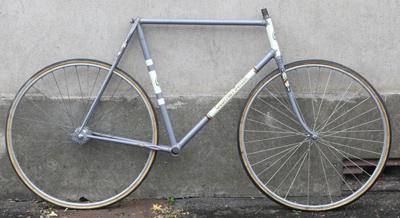
GILLOTT TRACK FRAME 1958 23.5in
Seat Tube (ctt): 23.5in (59cm)
Top Tube (ctc): 23in (58cm)
Rear dropout width: 120mm
Wheel size: Sprints/700C with a brake drop of 58mm
Frame tubing: Reynolds 531 double butted
Seatpost size: 27.2mm
This is a Gillott track frame from 1958 despite the Geoffrey Butler decals – its most definitely an old repaint which I think is from the 1960s. For more information on Gillott please see : http://www.classiclightweights.co.uk/gillott.html The paint is in lovely condition and it would be a shame to repaint it in some respects…A rare and very beautiful frame. £295
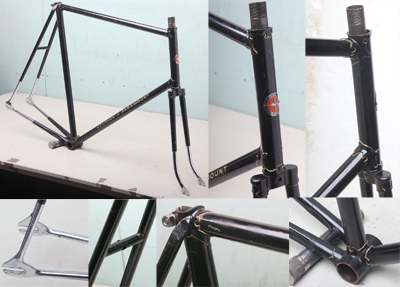
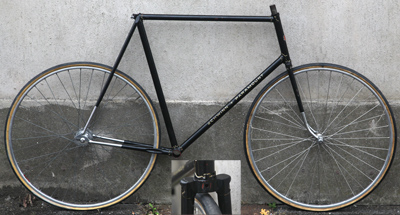
SCHWINN PARAMOUNT TRACK 1966 24.5in
Seat Tube (ctt): 24.5in (62.25cm)
Top Tube (ctc): 23.75in (60.25cm)
Rear dropout width: 120mm
Wheel size: Sprints/700C with a brake drop of 49mm
Frame tubing: Reynolds 531 double butted
Seatpost size: 27.2mm
Schwinn introduced their top end Paramount series of racing bikes in 1938 and the Paramount series was the US race bike for many years. This track frame is very typical built with Reynolds 531 double butted tubing and Nervex Pro lugs and dates from 1966. A lot more on Schwinn Paramounts can be found at: https://bikehistory.org/bikes/paramount/ The original paint is in very good to excellent condition with only a few small marks. £375
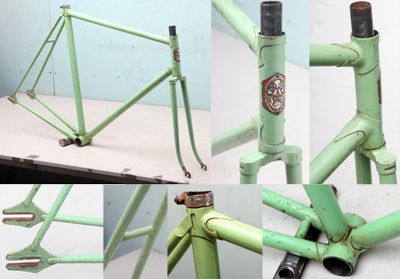
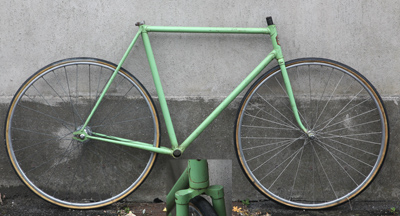
OLMO PISTA 1950s 56cm
Seat Tube (ctc): 56cm (22in)
Top Tube (ctc): 56cm (22in)
Rear dropout width: 110mm
Wheel size: Sprints/700C
Frame tubing: Not known
Seatpost size: 27.2mm
In the late 1940s and early 1950s Olmo frames were really superb – I have a truly beautiful touring frame with long lever Cambio Corsa gear in my own collection. This pista frame is equally superb – but it does need repainting… It has modern quite steep angles and close clearances. £375
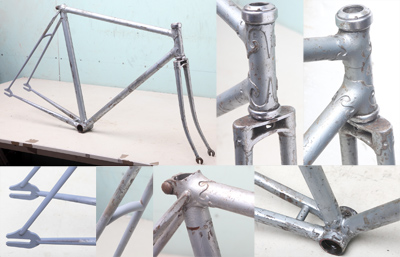

GRANBY TRACK c1948 21in
Seat Tube (ctt): 21in (53cm)
Top Tube (ctc): 22.5in (57cm)
Rear dropout width: 110mm
Wheel size: Sprints/700C with a brake drop of 57mm
Frame tubing: Reynolds 531 double butted
Seatpost size: 27.2mm
In the 1920s and 30s Granby was considered to be one of the cutting edge framebuilders with several innovations to their credit as well as considerable success on the track and in time trials. Granby was founded earlier – they claimed in their advertising in the 1920s that they were founded in 1913; a later letter from Percy Dean in Bicycle in 1952, one of the two partners claimed 1910 and furthermore claimed that they were first British company to pioneer the new style of lightweight bicycle that became popular after the First World War and that they introduced this style prior to the war. In 1926 they launched their taper tube design. In 1930 Granby introduced another innovation – chainstays that were square in section at the bottom bracket end. The business was sold to new owners about the time of WWII. But the new owners retained many of the special features and introduced new ones of their own – fancy hand-cut lugs and a special headset. More details on Granby can be found at: http://www.classiclightweights.co.uk/granby.html
This track frame dates I think from about 1948 and features some rather beautiful lugs, their new headset and the square section chainstays developed back in 1930. I had new Chater-Lea dropouts fitted by Tom board back in the late 1980s – the original ones were very badly chewed up. It obviously needs painting – decals are available. £265
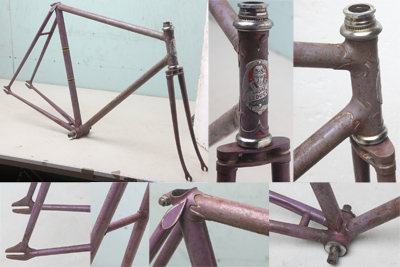
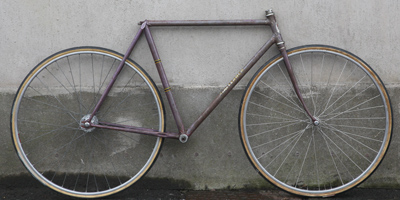
ANDRE LEDUCQ TRACK FRAME c1953 53cm built by Mercier
Seat Tube (ctc): 53cm (21in)
Top Tube (ctc): 56cm (22in)
Rear dropout width: 115mm
Wheel size: Sprints/700C
Frame tubing: Not known
Seatpost size: 26.6mm
André Leducq was a very accomplished French professional rider who won the Tour de France twice and rode for Mercier from 1934–39. In the late 1930s Mercier introduced a range of high-end bicycles bearing his name. They continued after WWII into the early 1950s. This track frame is gorgeously built – I suspect it may have been built for one of their top riders its of a quality rarely seen on French frames except for those built by the Constructeur builders – Herse, Singer, etc The lug shorelines are stuningly precise and the brazing perfectly clean. The paint is not in very good condition but I think it should definitely not be repainted. The frame is in excellent condition and built from a light double butted metric sized tube set, quite possibly Reynolds 531. £450
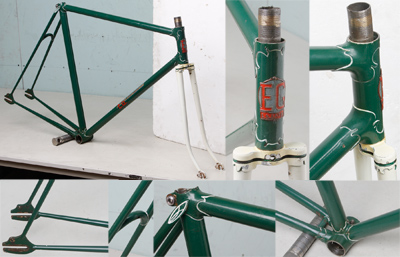
E G BATES ROAD TRACK FRAME 23.5in
Seat Tube (ctt): 23.5in (59cm)
Top Tube (ctc): 23in (58cm)
Rear dropout width: 115mm
Wheel size: 27in or Sprints/700C with a brake drop of 63mm
Frame tubing: Reynolds 531 double butted
Seatpost size: 27.2mm
Horace Bates founded Bates Cycles in August 1926 at 2a Swete Street, London E13 after he had been sacked from Hawkes Cycles for refusing to work late one night. E G Bates joined his brother in the business in 1927 and the business then became known as Bates Brothers. Soon after they moved to larger premises at 632 Barking Road which was about opposite the later EG Bates shop at 589–591 Barking Road. Soon after WWII in 1947 the two brothers decided to split the business in two. Horace took the branches and retained the Cantiflex design whilst E.G. kept the head office and original shop at Barking Road. Horace's firm now became known as Bates of London. More can be found on Bates at: http://www.classiclightweights.co.uk/builders/bates.html
This road-track frame from I think the later 1950s or early 1960s has been well repainted albeit with down-tube and seat tube decals from Horace Bates. Its in excellent condition. £225
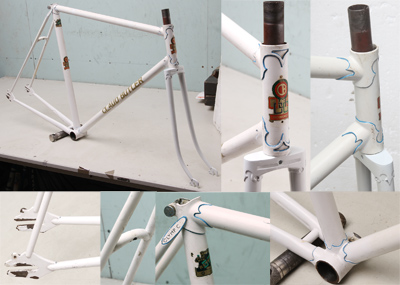
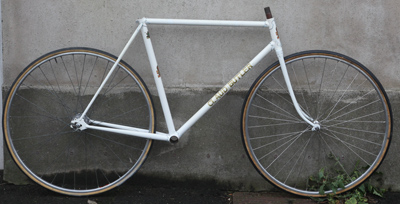
CLAUD BUTLER OLYMPIC ROAD/TRACK FRAME c1962 22in
Seat Tube (ctt): 22in (56cm)
Top Tube (ctc): 22.5in (57cm)
Rear dropout width: 114mm
Wheel size: 27in or Sprints/700C with a brake drop of 60mm
Frame tubing: Reynolds 531
Seatpost size: 26.4mm
This Claud Butler Olympic Road/track frame was built at the Holdsworthy factory from Reynolds 531 tubing. Lots more can be found on Claud Butler at http://www.nkilgariff.com It dates I think from 1962. Its in very good useable condition. £195
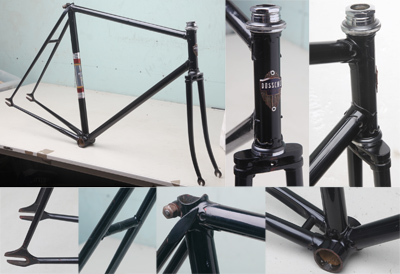
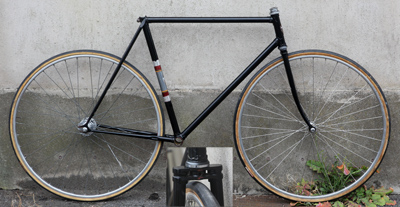
DOSSCHE SPORT TRACK FRAME 54cm 1950s
Seat Tube (ctc): 54cm (21.25in)
Top Tube (ctc): 56cm (22in)
Rear dropout width: 115mm
Wheel size: Sprints/700C with a brake drop of 42mm
Frame tubing: Not known
Seatpost size: 27.2mm
Dossche Sport are – were a very well respected Belgian framebuilder… This track frame with Nervex Pro lugs and Bastide type fork crown is exquisitely built. – just take a look at the very clean brazing and filework. This frame is in really nice condition – there’s one tiny ding to the top tube but its very hard to see…It has the steep angles and tight clearances found on most Belgian track frames – their tracks are normally short and steeply banked… £295
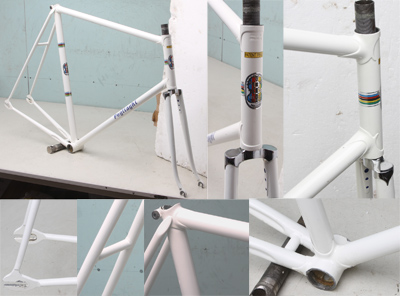
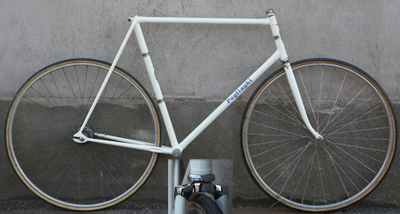
** SPECIAL REDUCED PRICE**
POGLIAGHI TRACK FRAME c1963 59cm
Seat Tube (ctc): 59cm (23.5in)
Top Tube (ctc): 57cm (22.5in)
Rear dropout width: 120mm
Wheel size: 700C/sprints
Seatpost size: 27.2mm
Frame Tubing: Columbus double butted
Sante Pogliaghi was one of Italy’s most revered framebuilders through the 1960s and 70s ranking alongside Cinelli, Masi and De Rosa. This track frame dates from c1963 and has been very nicely restored. The frame exudes pure quality… Very, very rare. £925

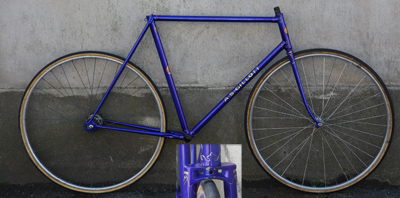
GILLOTT FLEUR DE LIS TRACK FRAME 1954 23in
Seat Tube (ctt): 23in (58cm)
Top Tube (ctc): 22.5in (57cm)
Rear dropout width: 110mm
Wheel size: 700C/sprints with a brake drop of 46mm
Seatpost size: 27.2mm
Frame Tubing: Reynolds 531 double butted
Gillott frames are renowned for being built to consistently high standards – this was down to employing excellent framebuilders and Harry Carrington who was stickler for quality. More on Gillott can be found at: http://www.classiclightweights.co.uk/gillott.html
The Fleur de Lis was Gillott’s top model and is very beautiful. Though this frame has mudguard eyes it has very close clearances and quite steep frame angles so I think was built with track use mostly in mind. It has been beautifully restored at Argos Cycles in Bristol and not used much since. It has a few small marks and is ready to be built up. £695
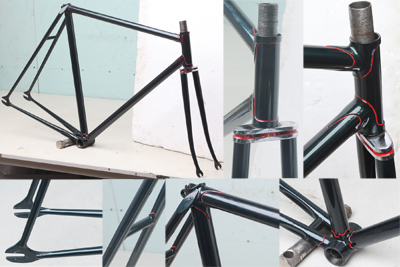
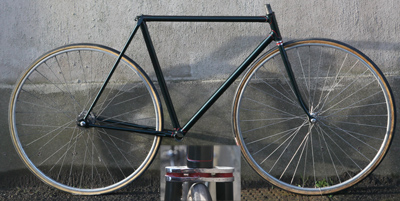
** SPECIAL REDUCED PRICE**
GERMAN TRACK FRAME Possibly Rickert 52cm 1960s
Seat Tube (ctc): 52cm (20.5in)
Top Tube (ctc): 54cm (21.25in)
Rear dropout width: 116mm
Wheel size: 700C/sprints
Seatpost size: 27.2mm
Rickert was one of the top German framebuilders. The German Rickert expert thought that this track frame was very likely to be a Rickert. This frame exudes quality just like most Rickert frames. The paint and chrome are in excellent condition. It has typical steep track frame angles and close clearances and is not drilled for brakes. £245
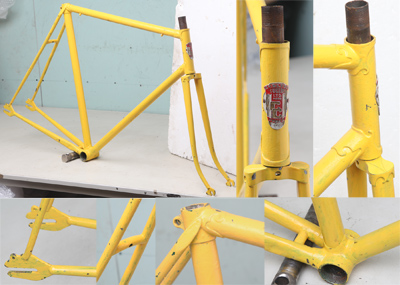
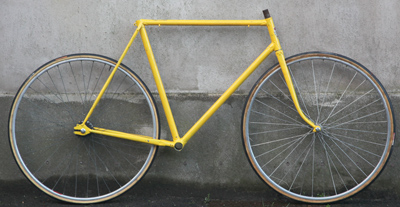
** SPECIAL REDUCED PRICE**
CARLTON COUREUR ROAD-TRACK 23in c1955 Fancy lugs
Seat Tube (ctt): 23in (58cm)
Top Tube (ctc): 22.5in (57cm)
Rear dropout width: 110mm
Wheel size: 700C/sprints with a brake drop of 62mm
Seatpost size: 27.2mm
Frame Tubing: Reynolds 531 double butted
This is a very unusual model of Carlton track frame – its in the 1955 catalogue. The Coureur model was mostly marketed as a road frame but they listed a road-track version which is what this is. The fancy lug design was unique to the Coureur model. The frame appears to be in very sound condition but had been given a very rough coat of paint… £195
    
Featured Frames
British and American road frames smaller than 21.5in
British and American road frames 21.5in–22.5in
British and American road frames larger than 22.5in
Bargain Basement
Classic Road frames pre-1970 smaller than 21.5in
Classic Road frames pre-1970 21.5in–22.5in
Classic Road frames pre-1970 larger than 22.5in
Classic Track & Road-Track frames pre-1970(look above)
European frames 56cm or smaller
European frames larger than 56cm
Italian frames 56cm or smaller
Italian frames larger than 56cm
Lo-Pro & Retro Time Trial frames
Touring frames
Track frames

|

SHIPPING COSTS
UK: £18
Europe: £35
North America: £90
Japan, Asia, Australasia, Africa, Middle East, South America: £115
Figures above are good estimates, rates may vary for some countries.
Contact us for more info.
CLICK ON the sale images to see a much larger picture!
FRAME CONDITION
Frames are supplied as seen in the pictures unless described otherwise in the text.
Please remember that these frames are generally at least twenty years old and sometimes seventy… In most cases I will know very little of their history but will attempt to describe any problems I can spot – if there are issues I have missed I will always work with the buyer to find a solution.
All frames I sell are in track and straight, with excellent headset threads, bottom bracket shell threads and gear hanger threads if fitted.
I will make every attempt to ascertain whether paint is original, an older repaint or a more recent repaint. Paint quality does vary quite bit…
These categories may be qualified by more detailed description in the text.
Excellent A very useable frame with no obtrusive marks to the paint and no dings or dents. Chrome if present will be free of serious marks unless stated otherwise.
Very Good Perfectly useable frame but with more marks to the paint and chrome if present. Some of the marks may benefit from careful retouching. Generally there will no dents or dings but if present will be small. However if you are concerned about dents/dings with frames in this category please ask me to do an extra check.
Sound Paint and chrome may need redoing depending on how you like your bikes – I appreciate frames with patina which show their age but others may want to repaint. There may be a small ding or two but nothing very significant – older frames often pick up smaller dents which are of no significance to their strength or life. Any more significant dents will be described in the text.
Needing repainting Paint will be poor and in my opinion is not saveable. There may be a small ding or two but nothing very significant – older frames often pick up smaller dents which are of no significance to their strength or life. If there are larger dents they will be described and/or pictured. These are all easily filled by a good framebuilder or frame painter at very little extra cost.
Headsets or bottom brackets fitted to frames are of unknown and unguaranteed condition unless specifically described in the text. Sometimes headsets or bottom brackets will not feel smooth and simply need a service and on other occasions the headset or bottom bracket will need replacing…
For frame without headsets or where you'd like a headset replaced I can offer a fitting service for £15. Please see the headset pages: http://hilarystone.com/headset.html for what is available but please bear in mind that you may need advice on whether a particular headset will fit your frame especially in relation to stack height.
|
























